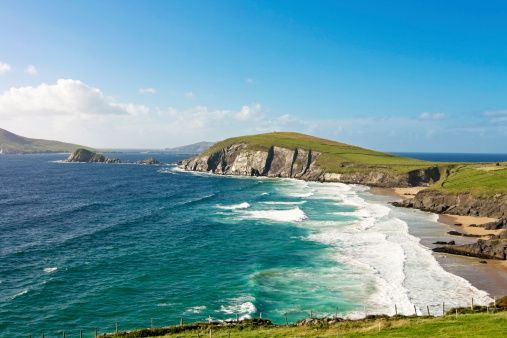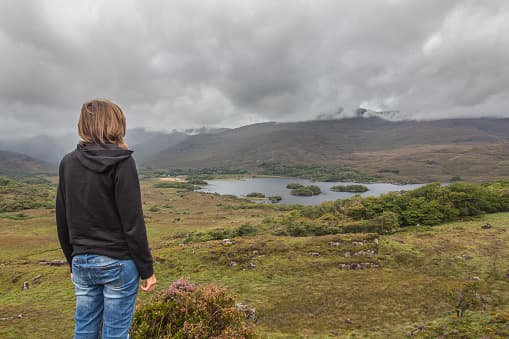How Long Is The Ring Of Kerry?
Scenic Route Guide

- the Gap of Dunloe
- Torc Waterfall
- Derrynane House
- Ladies View
- Valentia Island
- Portmagee village.
If you’re an adventure lover, there are tonnes of activities to do in this area, such as surfing, cycling, riding, fishing and hiking, so don’t feel that you’ll be limited to the car.
The ring is 179 kilometres in total (about 111 miles) and can be driven in a day, however the route shouldn’t be rushed. There is so much to see and do, we’d suggest staying overnight and making the most of it over a couple of days. Just remember to take out the relevant car or travel insurance before you go so you’ve covered against accidents.
Where is the Ring of Kerry?
The Ring of Kerry is located around the largest southwestern peninsula in Ireland, Iveragh Peninsula. The top of the peninsula, Killarney, is located around an hour and 30 minutes away from Cork or an hour and 50 minutes from Limerick.
Where to start the Ring of Kerry
According to the official Ring of Kerry website, you should start the route in Killarney and drive anticlockwise towards Beaufort and Killorglin. Killarney is a town situated on the beautiful Lough Leane in the National Park. You’ll drive over and around the mountains, where you’ll be rewarded with stunning views and scenery. This town is also where you’ll finish the drive, completing the entire loop.
Beaufort is the next stop on this route, but if you’re not careful, you’ll miss it. You access the village by turning off the main road and taking a small bridge over the River Laune. It’s an excellent place to stop for avid walkers, golfers and fishers.
If you continue to follow the Ring of Kerry, you’ll arrive in Killorglin, a town famous for capturing wild goats and crowning them king before releasing them into the wild during the Puck festival. The festival can draw crowds of up to 30,000, so avoid the area if you want a relaxing, peaceful holiday or make the most of the spectacle if you’re intrigued.
When you leave Killorglin, you’ll drive away from the River Laune. Keep driving until you go past the Kerry Bog Village Museum. Shortly after this you’ll find a viewpoint where you can take some stunning photos of the surrounding scenery.
The next village you’ll reach is Glenbeigh. It’s located very near to the coast and boasts one of Ireland’s most beautiful beaches, Rossbeigh. Whether you’re looking for a memorable family trip to the seaside, a long walk along the coastline or to try your hand at watersports, you won’t be disappointed by this Blue Flag beach.
Glenbeigh is closely followed by Cahersiveen, a market town that has a population of around 1,200.[3You can drive over Castlequin Bridge, which offers beautiful vistas of the marina and harbour. There are a plethora of great places to eat along Church Street in Cahersiveen.
The next major town is Waterville, however we think it’s worth turning off the main road and taking the R565 down to Portmagee. Portmagee is a harbour village that is picturesque in every way. From here, drive around Valentia island or take a boat from the harbour out to Skellig Michael, where you can see Skelligs Lighthouse and St. Fionan’s Monastery. To find out more about the history of the Skellig Islands, visit the Skellig Experience Centre in Portmagee.

Before you arrive in Ballinskelligs, we’d recommend stopping at the Kerry Cliffs for the best views along the whole Ring of Kerry. After taking in the incredible view of Puffin Island and the Skelligs from these 300-metre high cliffs, carry along the Skellig Ring until you reach Ballinskelligs. These roads tend to be too narrow for tour buses, so the route becomes a little quieter at this point. The scenery here is phenomenal, offering a variety of rugged coastlines, mountains, beaches and blue water.
From here, you can rejoin the ‘Ring of Kerry’ road (N70) to Waterville. You have the chance to view the Celtic Sea on one side and Lough Currane on the other. It’s the only village on the Ring of Kerry that is directly on the coast.
Sneem is the next village on the route. Located on Kenmare Bay, its traditional buildings and pubs are painted in lots of beautiful colours and it’s a wonderful place to relax after the busyness of the journey up to this point. Wander around Sneem Sculpture Park, enjoy the colours, fragrance and birdsong in the Garden of the Senses and listen to the waves crashing against the sun-bleached algae at Coral Beach.
Kenmare is the stop after Sneem. Originally a plantation colony, it’s a small town located between the MacGillycuddy Reeks and the Caha mountains]. There are plenty of B&B’s here, making it the perfect place to stay over.
Now, you’ll be on the last leg of your journey, back to Killarney. Before you get here, you should make a quick stop at Moll’s Gap. It offers views of the MacGillycuddy’s Reeks and the chance to see the red sandstone rocks that have been stained green over the years. Continue along the N70 and you’ll find yourself back in Killarney.
How long will it take to drive the Ring of Kerry?
As you can probably tell from the route above, there is a lot to see and do along the Ring of Kerry. While you can drive the entire route in one day, you may not get the most out of the trip this way. Turning it into a two or three day road trip could make it even more special.
You could drive the whole ring in three hours if you don’t make any stops. But this can be broken up by seeing some sights, stopping for food and even staying overnight.
Is the Ring of Kerry dangerous to drive?
The Ring of Kerry isn’t dangerous to drive, however you do need to be extra careful in places. The roads can be narrow and windy and some are close to cliff edges. Give yourself plenty of time to slow down for other drivers and animals that might be crossing the road.
You should always make sure to have the correct car insurance when heading on any form of road trip. Why not get a car insurance quote or give us a call on 01 400 3400.
